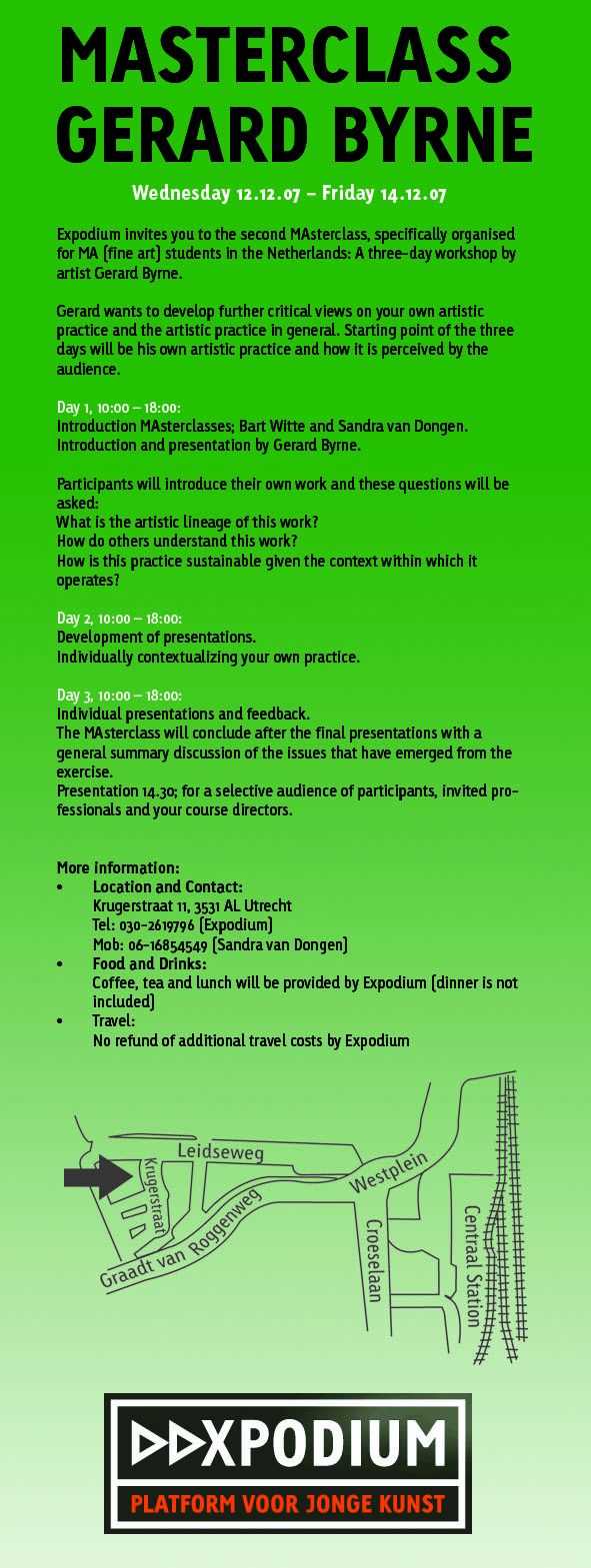2007 OUTSIDE ACADEMY : Masterclass by Gerard Byrne / organised by Expodium for DAI and other Dutch master programs
DAI students Emily Williams, Nikos Doulos, Chris Meighan and Julien Grossmann joined this masterclass
Proposal Gerard Byrne
Lineage, Perception, and Praxis
Lets begin with a question: What makes Masters Level education different to under-graduate education? Among the differences I would point to, is a difference of emphasis in the types of discussions that surround what's happening in the studio. At undergraduate level, there is a pre-occupation with the singular mechanics of making an artwork from the beginning. At this level the questions are how to decide on materials? what skills are needed to work with those materials? and how does the work made assert it's status as art? At Masters level, while these questions persist, there is an increasing awareness of how artworks are understood within a critical context, and how students begin to affirm a position for their studio practices within their perceived idea of the spectrum of contemporary art. This new emphasis on perceived critical positions tends to gather momentum relentlessly throughout the course of the Masters programme, reaching a cresendo in the supposed 'statement' of the final exhibition.
Such an experience of Masters programs is fairly universal given that most Masters programs are based on similar models. Unfortunately the mapping out of the spectrum of contemporary art practices and the students jostling for artistic positions within that perceived spectrum, is a process that is often masked, or at best, only partially discussed, within the programs themselves.
The purpose of this workshop is to address this process directly through condensing it into a singular direct process. The aim of the workshop is not to reach a conclusion as to the future artistic prospects or positions of the student participants. Rather the aim of the workshop is to gently introduce the students to the process in a non-challenging context where we can discuss issues like how an artist positions their practice in relation to the practices of others, how an artists practice is perceived by others, and how an artist can imagine a practice that's sustainable beyond the present moment.
Day One:
The masterclass begins with a presentation by me in which I try to mark out in a critically frank manner a sense of my own practice as understood in relation to others: What is my sense of the artistic lineage for my work? What is my sense of how my work is understood by others? How do I see my practice as being sustainable in the future given the context within which it currently operates? This introduction will be completed by a critical response from workshop participants, in which they might propose alternative perceptions of where my work fits in to their sense of the spectrum of artistic practices.
During the afternoon of day one, students will each present one or two representative examples of their work to the group through some visual form - either through documentation or actual spatial presentation. Although the work should be presented in a form that allows for it to be fully comprehended, at this point participants will not be asked to verbally contextualise the work. Participants will instead be asked to make notes on the presentations of each of the other participants. The notes should address the following questions:
What is the artistic lineage of this work?
How is this work understood by others?
How is this practice sustainable given the context within which it opperates?
Day Two:
I will work with participants to individually develop presentations which respond to the issues of context and perception characterised in the questions above. Our meetings will focus on each participants perceived sense of the trajectory of their own work, as well as formulating notes on the practices of each of their peers within the group. Presentations can take any form - either a live lecture, a fixed display of work related materials, or a video based presentation. The focus of the presentations will be on how participants contextualise their practices as a whole, in the context of the history of related practices, and in the broader context of contemporary art practices. Students should also discus the future prospects for their practices in terms of critical reception
Day Three:
In the morning participants will begin their presentations. After each presentation, the group will collectively feedback, - responding by affirming and / or critiquing the appropriateness of the contextualisation provided by each participant in their presentation. Each participant will contribute to each others presentation by feeding back their sense of the the trajectory of the work based on the notes they've formulated on day 2. The masterclass will conclude after the final presentations with a general summary discussion of the issues that have emerged from the exercise.
As stated above, the hope is that by condensing into a benign workshop situation the complex and at times quite abstract process of artistic positioning that pervades M.A. programs, students can more comfortably address the process within their experience of Masters program education.

